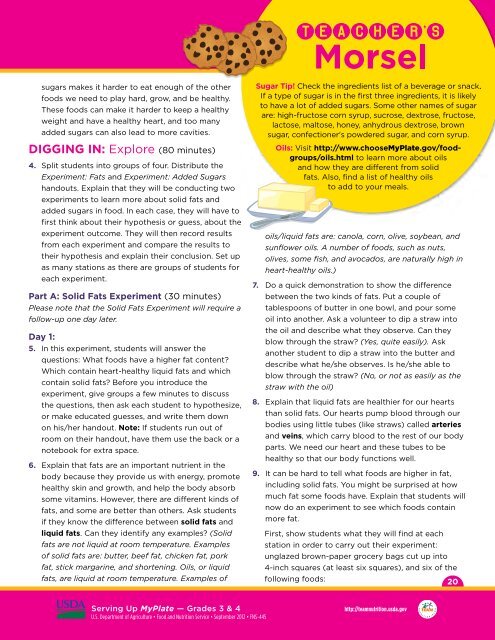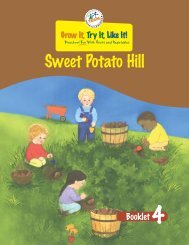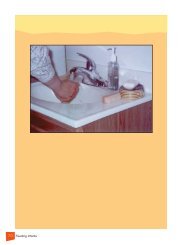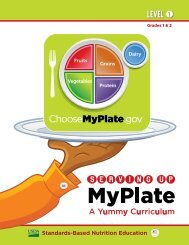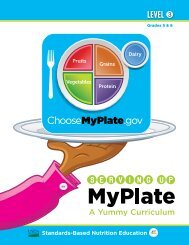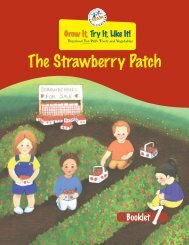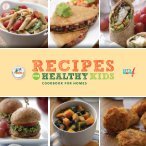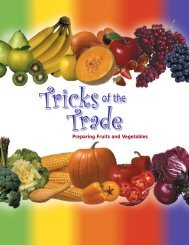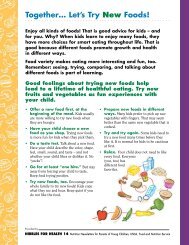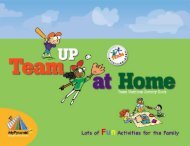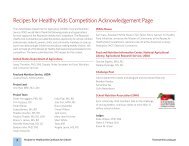Serving Up MyPlate-A Yummy Curriculum, Level 2 - Team Nutrition ...
Serving Up MyPlate-A Yummy Curriculum, Level 2 - Team Nutrition ...
Serving Up MyPlate-A Yummy Curriculum, Level 2 - Team Nutrition ...
You also want an ePaper? Increase the reach of your titles
YUMPU automatically turns print PDFs into web optimized ePapers that Google loves.
sugars makes it harder to eat enough of the other<br />
foods we need to play hard, grow, and be healthy.<br />
These foods can make it harder to keep a healthy<br />
weight and have a healthy heart, and too many<br />
added sugars can also lead to more cavities.<br />
DIGGING IN: Explore (80 minutes)<br />
4. Split students into groups of four. Distribute the<br />
Experiment: Fats and Experiment: Added Sugars<br />
handouts. Explain that they will be conducting two<br />
experiments to learn more about solid fats and<br />
added sugars in food. In each case, they will have to<br />
first think about their hypothesis or guess, about the<br />
experiment outcome. They will then record results<br />
from each experiment and compare the results to<br />
their hypothesis and explain their conclusion. Set up<br />
as many stations as there are groups of students for<br />
each experiment.<br />
Part A: Solid Fats Experiment (30 minutes)<br />
Please note that the Solid Fats Experiment will require a<br />
follow-up one day later.<br />
Day 1:<br />
5. In this experiment, students will answer the<br />
questions: What foods have a higher fat content?<br />
Which contain heart-healthy liquid fats and which<br />
contain solid fats? Before you introduce the<br />
experiment, give groups a few minutes to discuss<br />
the questions, then ask each student to hypothesize,<br />
or make educated guesses, and write them down<br />
on his/her handout. Note: If students run out of<br />
room on their handout, have them use the back or a<br />
notebook for extra space.<br />
6. Explain that fats are an important nutrient in the<br />
body because they provide us with energy, promote<br />
healthy skin and growth, and help the body absorb<br />
some vitamins. However, there are different kinds of<br />
fats, and some are better than others. Ask students<br />
if they know the difference between solid fats and<br />
liquid fats. Can they identify any examples? (Solid<br />
fats are not liquid at room temperature. Examples<br />
of solid fats are: butter, beef fat, chicken fat, pork<br />
fat, stick margarine, and shortening. Oils, or liquid<br />
fats, are liquid at room temperature. Examples of<br />
oils/liquid fats are: canola, corn, olive, soybean, and<br />
sunflower oils. A number of foods, such as nuts,<br />
olives, some fish, and avocados, are naturally high in<br />
heart-healthy oils.)<br />
7. Do a quick demonstration to show the difference<br />
between the two kinds of fats. Put a couple of<br />
tablespoons of butter in one bowl, and pour some<br />
oil into another. Ask a volunteer to dip a straw into<br />
the oil and describe what they observe. Can they<br />
blow through the straw? (Yes, quite easily). Ask<br />
another student to dip a straw into the butter and<br />
describe what he/she observes. Is he/she able to<br />
blow through the straw? (No, or not as easily as the<br />
straw with the oil)<br />
8. Explain that liquid fats are healthier for our hearts<br />
than solid fats. Our hearts pump blood through our<br />
bodies using little tubes (like straws) called arteries<br />
and veins, which carry blood to the rest of our body<br />
parts. We need our heart and these tubes to be<br />
healthy so that our body functions well.<br />
9. It can be hard to tell what foods are higher in fat,<br />
including solid fats. You might be surprised at how<br />
much fat some foods have. Explain that students will<br />
now do an experiment to see which foods contain<br />
more fat.<br />
First, show students what they will find at each<br />
station in order to carry out their experiment:<br />
unglazed brown-paper grocery bags cut up into<br />
4-inch squares (at least six squares), and six of the<br />
following foods:<br />
20<br />
<strong>Serving</strong> <strong>Up</strong> <strong>MyPlate</strong> — Grades 3 & 4 http://teamnutrition.usda.gov<br />
U.S. Department of Agriculture • Food and <strong>Nutrition</strong> Service • September 2012 • FNS-445


